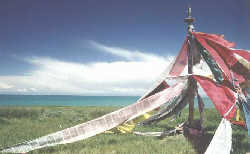| Chinese Way > Daily Highlight |
|
|
Prayer Flags
These flags, "Lung Ta" in Tibetan, are called "prayer flags" or "wind-horse flags," a literal translation of "Lung Ta": "Lung" meaning wind and "Tu" referring to horse in Tibetan. Wind horse of the early stages referred to fleeces hung on the trees or brushwood. Nowadays, the skeleton heads of flocks and herds can still be found among the Mani piles. In the mind of the Tibetans, wind horse refers to mankind's destiny and fortune, and in some special cases it points to the five elements (metal, wood, water, fire, and earth. held by the ancients to compose the entire physical universe, and later used in traditional Chinese medicine to explain various physiological phenomena). If a wind-horse flag is placed at the convergence of nimbus, the symbols on it will create an offering or prayer, which the wind distributes to the world every time it brushes against the flag. This is believed to be useful for the realization of a person's dreams. Just like any other art form in Tibet, the creation and distribution of prayer flags is promoted by its religious motif, and at the same time, acts as a medium for religious followers to communicate with the world of spirituality and divinity.
There is a legend about the creation of prayer flag: Once a monk obtained an
important scripture from India, but unfortunately got it wet in the river on his
way back. Having laid the scripture open to dry in the sunshine, the monk then
sat and meditated with his legs crossed under a big tree.
|
||||||||
 |

 Legends about prayer flags
Legends about prayer flags